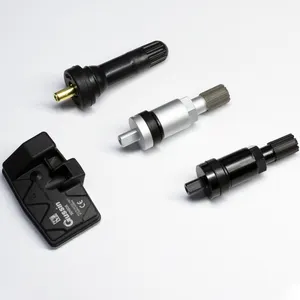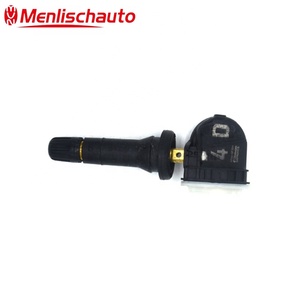(166 products available)






















































































































































































































A tire pressure monitoring system (TPMS) is an electronic system designed to monitor the air pressure inside the tires of vehicles. It alerts the driver in case of low or high-pressure issues, helping avoid tire-related accidents. The Schrader TPMS offers three types of sensors to meet different market needs and applications. These are the standard sensor, the programmable sensor, and the universal sensor.
The Standard Schrader TPMS sensor is the first-generation sensor that quickly and accurately detects changes in tire pressure. It is ideal for vehicles with factory-installed TPMS. The standard TPMS sensor comes pre-programmed with typical vehicle applications. Depending on the model, it can monitor tire pressure or both tire pressure and temperature.
The Programmable Schrader TPMS sensor is a second-generation sensor designed to be more versatile. The sensor can be programmed to match the specifications of different vehicle models. This eliminates the need for additional tools and makes it ideal for vehicles without factory-installed TPMS. The programmable TPMS sensor is suitable for vehicles with a diverse range of makes, models, and years. It is an excellent solution for car owners who may need to install a new TPMS sensor when replacing tires.
The Universal Schrader TPMS sensor is a third-generation sensor designed to be compatible with different vehicle makes, models, and years. It features a one-size-fits-all design, eliminating the need for programming or adaptation. The universal TPMS sensor is ideal for vehicles with factory-installed TPMS. It is a cost-effective solution for car owners who may need to replace their TPMS sensors over time.
Besides these three main types of Schrader TPMS sensors, the company also offers several other solutions for different market segments. For instance, the Schrader TPMS tool range includes activators, scanners, and programmers. Activators are handheld devices used to communicate with TPMS sensors and read tire data. Scanners are more advanced devices that can read, write, and program TPMS sensor data. Programmers are specialized tools used to change the settings of a TPMS sensor to match specific vehicle requirements.
Schrader also offers training and support services for automotive professionals and technicians. The company's training programs cover various TPMS topics, including sensor selection, installation, programming, and troubleshooting. With the right tools, knowledge, and skills, automotive professionals can efficiently handle TPMS-related tasks and provide excellent service to their customers. The tools, training, and support services are aimed at equipping automotive professionals and end users with the right tools and knowledge to handle TPMS-related tasks efficiently.
Sensor
Battery Life: Depending on the type of battery and usage, its life span is about 5-10 years. 2. Frequency of Transmission: Every 1-10 minutes, it will send information about the tire's health. 3. Operating Temperature: When things are hot or cold, it can keep working at -40 to 125 degrees Celsius (-40 to 257 degrees Fahrenheit). 4. Sensor Size and Weight: It is small, weighing only 5-20 grams (0.17-0.71 ounces) and measuring 20-50 mm (0.79-1.97 inches). 5. Measurement Range: It can measure 100 kPa (14.5 psi) to 900 kPa (130.5 psi) for pressure and -40 to 125 degrees Celsius (-40 to 257 degrees Fahrenheit) for temperature. 6. Accuracy: It can give precise information about how the tires are doing, with only a little error in measurements. Pressure: +/- 5 kPa (0.73 psi) and Temperature: +/- 2 degrees Celsius (3.6 degrees Fahrenheit). 7. Wireless Communication Protocol: It uses a secure and reliable protocol, such as Bluetooth or Zigbee, to communicate with the vehicle's onboard computer. 8. Energy Consumption: It is designed to use little energy to extend the battery life.
TPMS Tool
1. Compatibility: The device is designed to work with various TPMS sensors, including those from different car brands and models. 2. Display: The display size is between 2.4 and 4.3 inches, allowing the user to see the information clearly. 3. Battery Life: The battery lasts for 8-12 hours on a single charge. 4. Communication: It can talk to the TPMS sensors, either through wires or wirelessly, depending on the situation. 5. Operating Temperature: It can work well, even in very hot or cold places, at -10 to 50 degrees Celsius (14 to 122 degrees Fahrenheit). 6. Memory: The device has enough storage for around 1000 records, so users can look back at the information if they need to.
Tool Charger
1. Voltage: It has a voltage of 5-12 volts, making it safe and suitable for many tools. 2. Charging Time: It takes 2-4 hours to charge the battery fully. 3. Battery Type: The charger is designed for Li-ion, Li-poly, or NiMH batteries, making it suitable for many tools. 4. Communication: It can communicate with the tool, like updating software or changing settings. 5. Safety Features: It has features that keep it and the battery safe, like overcharge protection and short circuit prevention. 6. Indicator Lights: The indicator lights let you know the charging status, like charging, fully charged, or error.
Proper maintenance of Schrader TPMS is essential for optimal performance and longevity. Here are some general guidelines:
When buying a Schrader TPMS, consider the following:
Vehicle Compatibility
Ensure that the TPMS is compatible with the make, model, and year of the vehicle. Different vehicles may have varying requirements in terms of sensor frequency and communication protocols.
Quality and Reliability
Choose a branded or trusted aftermarket TPMS tool. Quality tools are durable and give accurate readings, ensuring that the tire pressure is always monitored and maintained correctly.
Frequency and Protocols
Schrader TPMS sensors operate at different frequencies (e.g., 315 MHz or 433 MHz). Ensure the frequency matches the vehicle's requirements to avoid communication issues. Additionally, consider the communication protocols supported by the TPMS sensor to ensure compatibility with the vehicle's onboard diagnostics system.
Ease of Installation
Some Schrader TPMS sensors may require professional installation, while others may be user-friendly for DIY installation. Consider the ease of installation and whether professional assistance is needed or if it can be installed independently.
Battery Life
Check the battery life of the chosen Schrader TPMS sensor. Long-lasting batteries reduce the need for frequent replacements, minimizing maintenance costs and ensuring uninterrupted tire pressure monitoring.
Data Display and Readability
Consider the TPMS display size and readability. Opt for a model with a clear and easy-to-read screen, allowing for quick data analysis while driving. Additionally, consider whether the TPMS provides real-time tire pressure monitoring, alerts for low/high-pressure situations, and temperature information.
Price
Compare prices from different suppliers and manufacturers to find a Schrader TPMS that fits the budget without sacrificing quality and reliability. Remember that cheaper models may have fewer features or shorter lifespans.
Warranty and Customer Support
Check the warranty period and customer support offered by the chosen TPMS manufacturer. A good warranty protects against defects, while reliable customer support assists with any questions or problems.
Here is how to replace a Schrader TPMS valve sensor step-by-step:
It is important to follow the manufacturer's instructions when replacing a Schrader TPMS valve sensor. Only trained personnel should attempt this.
Q1: Is it possible to reset a TPMS sensor?
A1: Yes, but the method varies depending on the system. While some require a special tool or a simple learning process to match new sensors, others can be reset with the right procedure.
Q2: How often should TPMS sensors be replaced?
A2: It is generally recommended to replace TPMS sensors every 5 to 7 years or after 50,000 to 70,000 miles, as their performance can degrade over time, affecting their ability to detect tire pressure changes accurately.
Q3: Can anyone install a TPMS sensor?
A3: While it is possible to install a TPMS sensor, the process requires specific knowledge and tools. Thus, it is recommended to have a trained professional or an experienced mechanic install them to ensure proper functionality and vehicle compatibility.
Q4: Does the Schrader TPMS require regular maintenance?
A4: Only a few do. Normally, maintaining the proper tire pressure and keeping the sensors clean and free from damage is enough. However, periodic checks by a professional to ensure the system's accuracy and functionality are essential.
Q5: Can TPMS sensors be used on different vehicles?
A5: No, each TPMS sensor is designed to be compatible with a specific vehicle's make, model, and year. Using a sensor not properly matched to the vehicle can result in improper fitting and communication issues with the ECU.